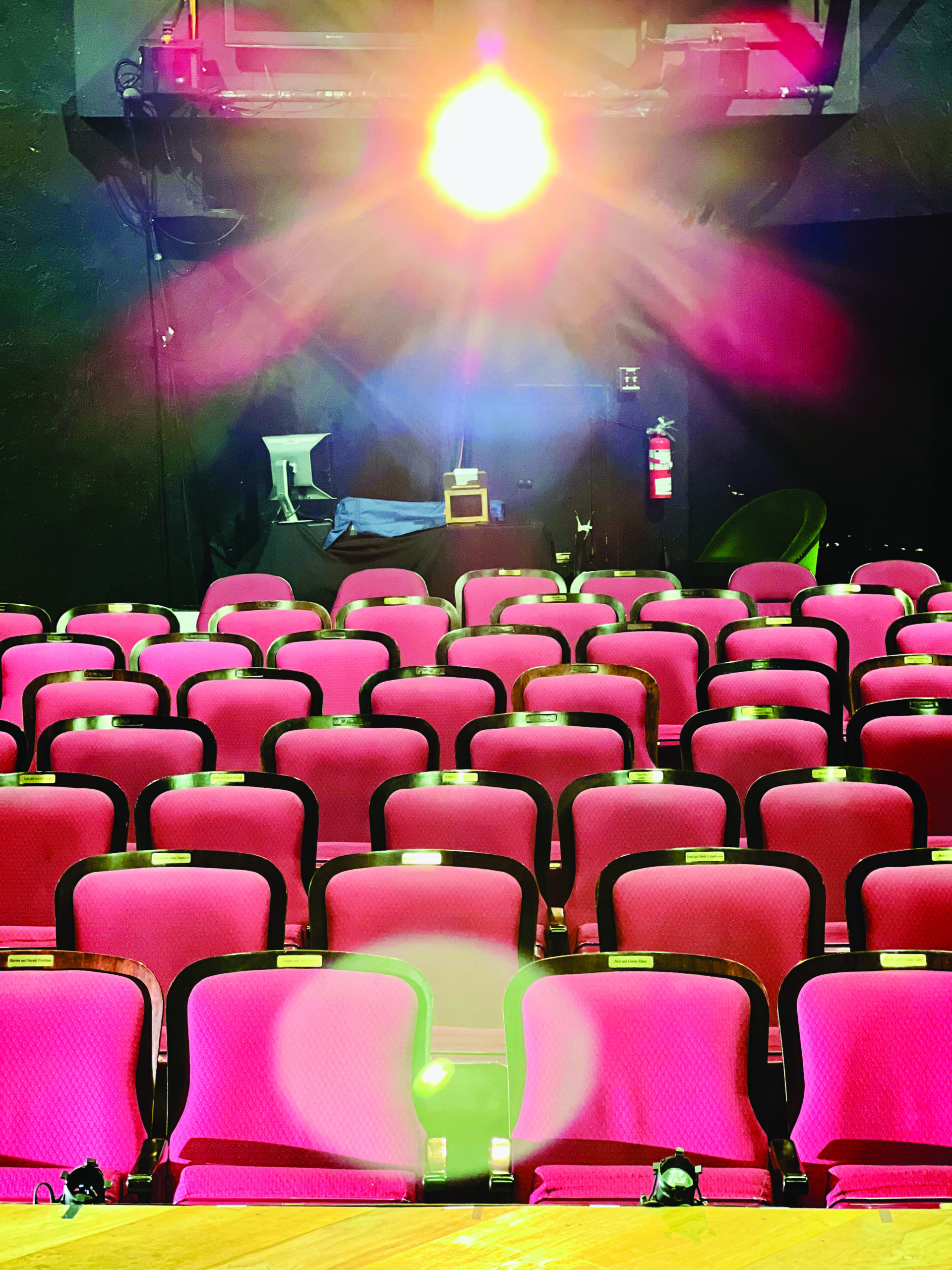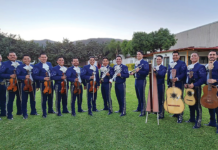By Kathryn Stelmach Artuso
Mexican Consulate in Oxnard hosts two commemorative art exhibitions.
The eagle wrestling with the snake is one of Mexico’s best known symbols. Yet in the hands of the artist Rafael Perea de la Cabada, the emblem takes on new significance and a deeper resonance. If you enter the Mexican Consulate in Oxnard to see such artwork, your eyes will immediately be drawn to the giant tapestry on the left wall, depicting the serpent and eagle intertwined in writhing, perpetual motion. The inextricability of the two animals is reflected in the title of the work, “Aguipiente y Serguila,” a play on words that mimics their endless, interpenetrating twist.
“Where, exactly, is the eagle?” you ask, backing up for a better perspective.
Perea de la Cabada chuckles. “An artist’s job is to raise questions, not provide easy answers.”
Such oppositional dynamism structures the two art exhibitions currently on display at the Consulate of Mexico in Oxnard, Cempohualli and Gráfica Mexicana, which run until the end of the year and are free to the public. The exhibitions, developed with support from the Port of Hueneme and the Oxnard Performing Arts Center, are a part of the commemoration of several anniversaries, including the bicentennial celebration of Mexican Independence in 1821, 500 years since the fall of the Aztec Empire in 1521, 700 years since the founding of Tenochtitlán (now Mexico City) in 1321, and approximately 100 years since the Mexican Revolution in 1920. (Perea de la Cabada’s entire series “Aguipiente y Serguila / Un México Para Armar” is concurrently on display at Universidad Autónoma Metropolitana in Mexico City.)
The dialectical interplay and tensions of Perea de la Cabada’s artwork continue as you enter the Cempohualli exhibition hall on the first floor, where images of male and female exist in delicate balance and occasional accord, as exemplified in his acrylic “Encyclopedia Series” and in his etchings titled “Unidad” and “Raices.” “Unidad,” in particular, showcases a harmonious androgyny, in which masculine and feminine elements exist in dyadic complementarity.
Perea de la Cabada notes that Cempohualli is the Aztec word for 20 or “full count,” like the total number of fingers and toes . . . and the total number of artworks in this exhibition. Yet it also denotes “a circle that rounds up,” echoing the cyclical anniversary celebrations and connoting images of revolution and counter-revolution, stasis and movement.
This opposition can be seen in another charcoal drawing from his “Aguipiente y Serguila” series, which displays the eagle and serpent poised on the nopal in compositional equilibrium, contrasting sharply with the swirling dynamism of the tapestry outside. Representing a “cultural stalemate” before a violent clash, the emblem has been reconfigured by Perea de la Cabada, who said he wanted to reinterpret or “own the symbol” for himself after seeing it
constantly throughout his life. With a diverse ancestral lineage, including Spanish, Italian and pre-Hispanic Indian, Perea de la Cabada draws upon a variety of ancient and contemporary influences in work that also encompasses an impressive variety of media.
“I create my own symbols to represent our times,” he said. “I feel I’m more like a composer, more than an interpreter . . . I want the work to have a meaning that is current to our times, even though there’s an ancient feeling to it.”
Believing in “letting the process dictate the direction of the work,” he also compares the artist to one who keeps water flowing smoothly, the one who “moves the paddle and tries to make it run again . . . finding all those situations in society that need to be shaken, that need to be moved.”
Nevertheless, he notes that art should not be didactic propaganda; in fact, the complex, ambiguous symbol of the eagle and serpent is associated with Aztec solar mythology and with the discovery of Tenochtitlán, but the image has accrued multiple layers of meaning over the years.
Peering closely at the charcoal drawing, Alexis Moreno of Oxnard said, “It’s a balance of both the snake and the eagle, and it looks like they’re balancing on the nopal, too. It represents our balance, and it’s calm. All three of the symbols are just — their own. They stand on their own.”
Rise and fall, push and pull
Upstairs is the second exhibition, Gráfica Mexicana, a collection of mid-20th-century lithographs and prints, curated by Perea de la Cabada, from the extensive collection of Gil García and Marti Correa de García of Santa Barbara. Near the top of the stairs is an etching by Alfredo Zalce, titled “Michoacán,” which portrays a family in exodus from their homeland, navigating a small boat to a new country.
A little farther down the hall, you notice a vibrant surrealist figure in “Affiche Avante Lettre,” a painting by Rufino Tamayo, one of Mexico’s best known artists, which reminds you of Perea de la Cabada’s “Unidad.” The fluctuating polarities in Perea de la Cabada’s work also echo Tamayo’s mural “Duality,” which appears in the National Anthropology and History Museum in Mexico City, revealing a serpent and jaguar locked in another conflict derived from Aztec mythology. The mural had a profound effect on Perea de la Cabada in his youth, before he moved to the U.S. at the age of 24 (after winning a national award) to pursue a master of fine arts degree at the University of California, Santa Barbara. Rafael Perea de la Cabada’s exhibition of his entire series Aguipiente y Serguila / Un México Para Armar is concurrently on display at UAM in Mexico.
Perea de la Cabada notes that such duality is “permeated all over Mexican culture,” and “you always feel that you are very vital when you’re in Mexico because you’re dealing sometimes with extremes . . . You really feel very alive.”
In the Consulate’s upstairs exhibition of Mexican modernism, Tamayo’s work appears alongside lithographs and prints by other famous artists such as José Clemente Orozco and David Alfaro Siqueiros, who were best known for their massive murals that celebrated Mexican culture.
Images of traditional agrarian life and the campesino (peasant farmer) exist in dynamic counterpoint to images of the Mexican Revolution, where even women wear cartridge belts and bandoliers, as shown in the linocut, “Estampas de la Revolución Mexicana,” by Mariana Yampolsky. Other highlights from the collection include images from the Bracero Program of migrant workers and images of Emiliano Zapata and Paul Leroy Robeson.
Like a Möbius strip or an ouroboros, the two exhibitions underscore the cyclicality of historical Mexican emblems and events, which deserve not only communal celebration but also aesthetic contemplation. Expressing gratitude for the generosity of the Garcías’ contribution, Euclides del Moral Arbona, the Head Consul, encourages the local and regional community to visit and enjoy the art exhibitions at the Consulate.
“We’re really looking forward to engaging our community and to engaging our constituency,” del Moral Arbona said, “to be aware of Mexico’s cultural richness and be proud of it.”
Gráfica Mexicana and Cempohualli are free and open to the public and will run through December 2021. When visiting the Consulate, please register and sign in downstairs before visiting the exhibition spaces.

























